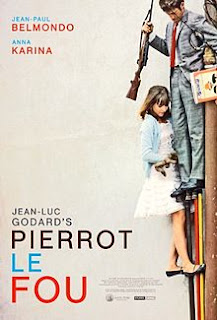In this 1965 wonder, Jean-Luc Godard takes two of the most prominent actors of 1960s France, Jean-Paul Belmondo and Anna Karina, and throws them into his crazy diegesis in the heart of France. With the title literally translating to "Pete goes Mad", this film shows Pierrot, or Ferdinand, and Marianne fleeing from Paris after mixings with some Algerian gangsters goes sour.
In typical Godard style, we are led on a whirlwind road trip of violence, craziness and romance, with the relationship between the two being tested throughout and the threat of the gangsters who are after them always on the mind of both the characters and the audience.
One of the most notable features of the film, and the characters themselves, is that they are extremely self aware. With ironic references being made to the fact that they are performing as characters "It's not a film" and direct lines being spoken towards the audience at several points throughout the film, the audiences interests are heightened as this non-conventional characteristic is put to use. Although the aim of these references is not clear, there are features of the film that are more easily analysed, such as the characters whispering to each other inside the car, clearly devising a sort of plan that will get them their petrol free of charge, however this whispering is done out of the camera's 'earsight' and therefore the audience is put in a strange position, not in the position of the two main characters, or in the position of the unaware petrol station attendee, we are hanging in a limbo of knowing that something is going to happen, but not what, and it causes tension for the time that we are stuck in this limbo, showing the genius of Godard's filmmaking and the unique environment that the audience is thrust in to.
It is obvious that the film is aimed at cinema lovers such as Godard himself, with the film presenting a variety of themes and combining them into one extremely interesting narrative. Ranging from romance, to violence, to crime, to drama, this film takes the audience on a journey that is highly enjoyable and provides a range of emotions. The narrative is linear, however there is a voiceover of both Marianne and Pierrot that we hear several times throughout the film, where they seem to both be telling their story as the film progresses, as one would tell a story at a party, or over dinner, possibly relating back to the first scene where Pierrot is unwillingly at a party, having to mingle with socialites and filmmakers. This on-and-off narrative reads like a book, which is reflected in the amount of times quotes from literature are read and discussed, and shows Godard incorporating other arts into his work, with the addition of paintings and the mention of Van Gogh to the cuts to flashing neon signs, representing the coming of modern art, Godard shows that he is a man in love with the arts and that he is proud of it.
This film takes viewers on a gratifying adventure, with constant musings of existential topics, it gives the audience more to think about and discuss that simply the story of two lovers on the run, and the various layers of this film make it an extremely interesting watch. With an explosive ending, cinematography that makes you want to book the next one-way plane ticket to Nice and performances by Karina and Belmondo that drive the emotions deep into the audience's heart, this film is not one to pass up on watching, and for those who perhaps aren't highly aware of French cinema, is a beautiful film to start on.


No comments:
Post a Comment